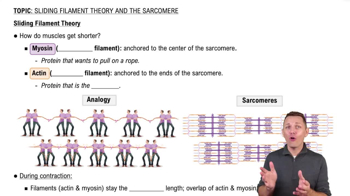Ms. Sanchez was in a motorcycle accident in which she lost the use of her right upper limb muscles due to significant nerve damage. However, when an electrode is inserted into her muscles, they are able to contract. Explain specifically why nerve damage caused her to lose the use of her muscles. Why can they still respond to stimulation from an electrode?
What is the basic mechanism of contraction at the level of myofilaments?
 Verified step by step guidance
Verified step by step guidance
Verified Solution
Key Concepts
Myofilaments

Sliding Filament Theory

Calcium Ions and Troponin

Match the following terms with the correct definition.
____Z-disc
____Sarcomere
____A band
____H zone
____I band
____M line
a. The dark band containing the entire length of the thick filament
b. The band of proteins in the middle of the H zone
c. The boundary between sarcomeres
d. The functional unit of contraction
e. The middle region of the A band containing only thick filaments
f. The light band containing only thin filaments
Mr. Nasheed has cerebral palsy and suffers severe skeletal muscle spasms as a result of his condition. He is prescribed the drug dantrolene, which prevents the release of Ca2+ from the SR. Explain how this will treat his muscle spasms.
Jesse is a 2-year-old boy who presents with difficulty in walking and poor control of movements. When the doctor examines Jesse, she notices that when his muscles contract, they are very slow to relax and remain contracted well after the movement has been performed. She sends a sample of his tissue for genetic analysis, and the lab reports a genetic defect that causes the pumps in the SR to operate much more slowly than normal. How does a defect in DNA lead to a malfunctioning protein? How does this finding explain Jesse's symptoms? (Connects to Chapter 3)
Paola is a 3-year-old girl with a disease that reduces the ability of her mitochondria to generate ATP. Explain the specific effects of this disease on the ability of Paola's muscles to function properly. What other tissues and organs are likely to be especially affected by her disease, and why? (Connects to Chapter 3)
Order the following events of excitation and excitation-contraction coupling. Put 1 by the first event, 2 by the second, and so on.
____The motor end plate generates an end-plate potential.
____The action potential spreads along the T-tubules, SR Ca2+ channels are pulled open, and Ca2+ flood the cytosol.
____Acetylcholine binds to receptors on the motor end plate, and ligand-gated ion channels open.
____Ca2+ bind troponin, which allows tropomyosin to move away from the actin active site, initiating a contraction cycle.
____The action potential propagates through the sarcolemma and dives deeply into the cell along the T-tubules.
